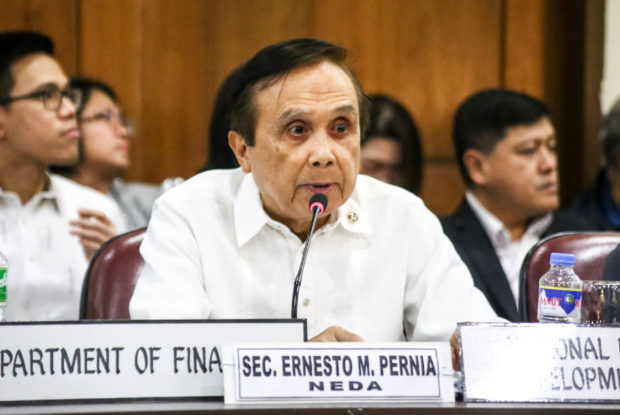The country’s chief economist has assured the public that the government is moving to arrest high consumer prices even as he noted that a confluence of domestic and external shocks were putting pressure on inflation.
In an e-mail to the Inquirer on Saturday, Economic Planning Secretary Ernesto Pernia said “it’s quite understandable why people (including my family) are now so sensitive to rising prices, especially of food and other basic needs, as we all have been used to relatively mild inflation.”
Data provided by Pernia, who also heads the state planning agency National Economic and Development Authority, showed that headline inflation averaged 2.8 percent during the term of former President Aquino, while it rose to an average of 3.2 percent under the Duterte administration thus far.
Across six administrations starting with former President Corazon Aquino’s, Pernia noted that “only P-Noy’s administration had the mildest average and peak inflation rates and, of course, better than Duterte’s.”
Under Corazon Aquino, inflation averaged 10.5 percent and peaked to 21.2 percent in Aug. 1991; Fidel Ramos’ term had average inflation of 8.1 percent and a peak of 13.9 percent in Feb. 1994.
Joseph Estrada’s term saw the rate of increase in prices of basic goods averaging 7.1 percent, with a peak of 10.7 percent in Jan. 1999.
During now House Speaker Gloria Arroyo’s term as President, headline inflation averaged 4.7 percent, peaking at 10.5 percent in Aug. 2008.
During the P-Noy administration, the highest inflation rate was 5.2 percent posted in June and Oct. 2011; so far under President Duterte, August’s over nine-year high of 6.4 percent was the fastest.
“But we must remember that P-Noy’s [administration] was lucky as that was still the aftermath of the global financial crisis that broke out in 2008, leading to low global interest and inflation rates. In turn, they facilitated the strengthening of macroeconomic fundamentals, the fruits of which, admittedly, have been carried over to the current administration and which we’re building on,” Pernia said.
As for the current elevated inflation environment, Pernia explained: “The US economy, arguably the global economic leader, has been normalizing since toward the end of the Obama administration and continuing with Trump’s as manifested by the series of Fed funds rate increases. Such normalization is spilling over to other countries, including ours.”
Locally, “consumer optimism used to be high until the particularly sharp spike in prices of the last two or three months,” Pernia noted.
The Bangko Sentral ng Pilipinas’ latest consumer expectations survey showed that the overall confidence index (CI) reverted to negative territory—which meant that pessimists outnumbered optimistic consumers—during the third quarter of the year, ending eight straight quarters of positive readings.
The CI for the July to September period fell to -7.1 percent from 3.8 percent in the second quarter.
On a personal note, Pernia said: “There’s also a textbook explanation of today’s diminished optimism or pessimism, referred to as the ‘revolution of rising expectations’ (Alexis de Tocqueville, 1856). This seems especially true with a rapidly growing economy and higher disposable incomes (helped by tax exemption for those earning monthly P21,000 or below, free tuition in state universities and colleges, free irrigation, etc.), as well as given easier and faster communication with information and communications technology and social media that quickly raise general awareness.”
Pernia was referring to the relief brought about by the passage of the Tax Reform for Acceleration and Inclusion (TRAIN) Act, as well as recent moves increasing government subsidies to students and farmers. The economy grew by an average 6.3 percent in the first half, below expectations but still among the fastest in the region.
“The above is merely an attempt to put things in perspective. It’s absolutely no excuse for the inflation affecting everyone, and that’s why we’re urgently proposing several cogent measures and reforms through an executive order to address and tame inflation back to our target range of 2-4 percent soonest,” Pernia said.
Last week, Pernia said that President Duterte was set to soon issue an EO, containing measures mostly removing food importation barriers earlier approved by the economic team, to ease high consumer prices.
In August, prices of fish and seafood jumped 12.4 percent year-on-year; rice, up 7.1 percent; vegetables, 19.2 percent; and meat, 7.6 percent.
When August prices were compared to levels in July, vegetable prices increased the most at 4.9 percent month-on-month, followed by rice at 2.1 percent, and fish and seafood 1.7-percent rise.
Pernia noted that inflation was actually declining month-on-month since February before again rising in August.
After the 0.9 percent month-on-month inflation increase in January, it declined to 0.7 percent in February, 0.5 percent both in March and April, and was flat from a month ago in May.
However, by June, consumer prices inched up by 0.6 percent month-on-month, 0.5 percent in July, and again rose to 0.9 percent in August. —BEN O. DE VERA
